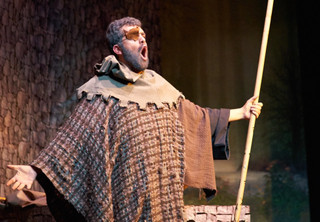|
Back
Wagner Premiere in Cincinnati Cincinnati
Arts Center at Dunham, West Price Hill
10/24/2014 - & October 26*, 2014
Richard Wagner: Siegfried, Act I
Timothy J. Bruno (Der Wanderer), M. Andrew Jones (Mime), Rob Rosenberg (A bear), Matt Tschimperle (Siegfried)
Queen City Chamber Opera Orchestra, Isaac Selya (conductor)
James Slouffman (stage director and set designer), Daniel Mazzone (scenic designer), Joy Galbraith (costume design), Sally Stewart (lighting design)

T. J. Bruno (© Kurt Strecker)
A singular event took place October 26 on a small stage in the Arts Center at Dunham in Cincinnati’s West Price Hill, act I of Richard Wagner’s Siegfried. Third installment of Wagner’s massive four-opera Der Ring des Nibelungen, it was a triumph for one of Cincinnati’s brightest young musical start-ups, Queen City Chamber Opera, now in its third season.
Conducted by Queen City Chamber Opera founder/artistic director Isaac Selya and presented in collaboration with the Wagner Society of Cincinnati, it was a Cincinnati premiere.
One thing the performance definitively established is that there are Wagner voices in Cincinnati. All three cast members, tenor M. Andrew Jones as Mime, heldentenor Matt Tschimperle as Siegfried and bass Timothy J. Bruno as the Wanderer, were trained at the University of Cincinnati College-Conservatory of Music. All displayed big voices, well able to project over the 43-piece orchestra, which included a hefty brass section. Close your eyes and you could imagine yourself in one of the great opera houses, hearing a starry cast.
Staging and direction were by James Slouffman, president of the Cincinnati Wagner Society. It was a simple set, consisting of a stone wall (Mime’s cave) against a misty, woods backdrop. In front were a forge, an anvil and a table and chairs. English surtitles (by Selya) were projected above the stage. With uniformly splendid singing and acting, it made for a thoroughly engrossing presentation.
Siegfried is the story of the young hero Siegfried’s coming of age after having been raised by the Nibelung dwarf Mime. In act I, Siegfried discovers who his parents were – his mother died in childbirth, his father in battle – and he insists that the dwarf repair and give him his father’s broken sword. Mime has been unable to do this, however, though he has tried many times, and Siegfried has broken all the other swords Mime has made for him.
During Siegfried’s absence in scene two, Mime is visited by the Wanderer – the king of the gods, Wotan, in disguise – and through a series of questions and answers, he is told by the Wanderer that only a person who does not know fear can re-forge the broken sword. Upon Siegfried’s return from the forest, Mime tries to explain to him the concept of fear, but Siegfried doesn’t understand. When Mime tells him about the dragon Fafner, who dwells in the forest guarding a hoard of gold, Siegfried determines to seek him out and see if he can learn fear. Impatient that Mime has not re-forged his father’s sword, Siegfried does it jubilantly himself.
The Queen City Chamber Opera Orchestra, led by Selya, set the scene beautifully in the act I prelude, a rich mix of Ring leitmotifs, including the darkly foreboding dragon motif. Jones and Tschimperle, a true heldentenor, with the weight and range to sing demanding Wagner roles, bickered convincingly, as Siegfried shows himself an ungrateful brat for Mime’s caretaking. One wished to applaud (almost) for Mime, despite his completely ulterior motive in raising the child, whom he believes can recover the all-powerful gold ring from Fafner. (After that, Mime plans to kill Siegfried and keep the ring for himself.)
Bruno, in a grey cloak and carrying a spear, brought a big, burnished voice to his role as The Wanderer and could easily be heard over the orchestra. This was true of the voices throughout (Tschimperle had to compete with the orchestra full bore at the pitch of the forging scene). Tschimperle showed himself a brilliant actor, too, placing his hand over his heart and looking confused as Mime tries to explain to Siegfried what fear feels like. He also made an excellent blacksmith, wielding his hammer on the anvil with clarity and precision. For his part, Jones portrayed the wily Mime with great skill and a solid tenor voice. Don Rosenberg made a charming bear, putting a fright into Mime in scene one.
This is the second presentation by Selya and Queen City Chamber Opera of excerpts from Wagner’s Ring. One hopes that there will be more and that perhaps someday (with Selya in the pit) Cincinnati will have its own Ring cycle.
Mary Ellyn Hutton
|